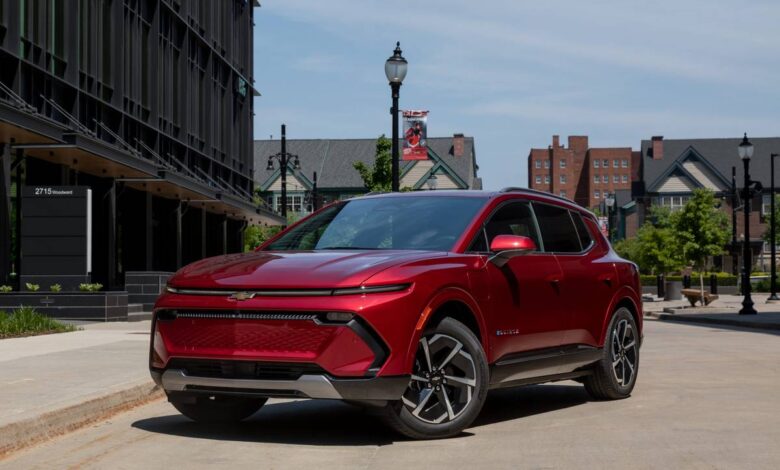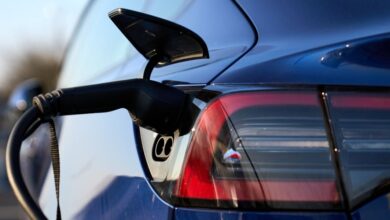2024 Chevrolet Equinox EV Review: The Apple-Pie Electric Vehicle

2024 Chevrolet Equinox EV | Cars.com photo by Christian Lantry
The verdict: The all-new 2024 Chevrolet Equinox EV is Chevrolet’s most mainstream electric vehicle yet; it’s a stylish, nicely equipped compact SUV that offers competitive range and charging speed at very competitive prices.
Versus the competition: The Equinox EV stacks up well against comparable trims of the Ford Mustang Mach-E, Hyundai Ioniq 5, Nissan Ariya, Tesla Model Y and Volkswagen ID.4, and it can be equipped with GM’s Super Cruise hands-free highway driving system.
In the mid-1970s, Chevrolet introduced one of its most memorable and successful advertising slogans: “Baseball, Hot Dogs, Apple Pie and Chevrolet.” The ad campaign was timed well to coincide with the patriotism and nostalgia of America’s 1976 bicentennial celebrations, and it sought to position the Chevrolet brand as a bedrock part of American culture.
Fast forward almost 50 years, and the all-new 2024 Chevrolet Equinox EV is starting to arrive in dealerships. America is still in the tumultuous early stages of transitioning from internal combustion engines to electric powertrains, but it’s clear that Chevrolet intends the Equinox EV to be its “apple pie” EV — it’s a value-focused compact SUV aimed right at the heart of the American market. I recently drove the Equinox EV in and around Detroit during its press preview event to find out if Chevy hit its target. (Per our ethics policy, Cars.com pays for its own travel and lodging when attending such manufacturer-sponsored events.)
Related: 2024 Chevrolet Blazer EV Review: Zappy Crossover, Shocking Price
The Equinox EV is by no means Chevrolet’s first electric vehicle. The recently discontinued first-generation Bolt EV inaugurated the modern era of GM EVs when it debuted for 2017, and the recently launched 2024 Blazer EV mid-size SUV marked Chevrolet’s first use of GM’s Ultium battery technology (which the Equinox EV also employs). However, neither the Bolt EV nor Blazer EV were really positioned for mainstream adoption. Despite its competitive specs and space efficiency, the Bolt’s subcompact dimensions and practical-hatchback styling limited its appeal, and the Blazer EV is positioned as a more premium offering with a starting price of around $50,000.
Meanwhile, the top trim level of the Equinox EV — the 3RS with all-wheel drive — just breaks the $50,000 mark. Later in the model year, a value-leader 1LT trim level is scheduled to debut with a starting price of $34,995 (all prices include $1,395 destination). The Equinox EV is built in GM’s Ramos Arizpe, Mexico, plant but still qualifies for the full $7,500 federal tax credit, lowering its bottom-line price even further for qualifying buyers.
Simple Model Lineup, Decent Power
Just as the Blazer EV shares nothing with the gasoline-engine Blazer SUV, the Equinox EV is a completely different vehicle than its internal-combustion-engine counterpart (which, by the way, has been redesigned for 2025 and is set to go on sale later in 2024). Its model lineup, however, sticks to Chevrolet’s standard format, with LT and sportier-looking RS trim levels — both with ascending numerical prefixes that indicate a higher level of standard equipment. (The LT and RS both come in “2” or “3” trims for now.)
Front-wheel drive is standard on all trims, and AWD is available for another $3,300. That might sound like an especially steep upcharge, but with electric vehicles, AWD almost always comes with a horsepower upgrade since another motor is needed to power the other pair of wheels.
Related Video:
FWD Equinox EVs are rated at 213 horsepower and 236 pounds-feet of torque. With AWD, those numbers are bumped up to 288 hp and 333 pounds-feet. I drove a FWD 2LT (starting price: $43,295) at the press preview event, and it delivered respectable acceleration, with the quick off-the-line response typical of electric vehicles. Even though the power plateaus noticeably after the initial thrust (a phenomenon we’ve noticed with other EVs — even high-performance ones), the front-drive Equinox EV should provide more-than-adequate go for most drivers. Chevrolet claims 0-60 mph times of around eight seconds for the front-drive Equinox EV and around six seconds for AWD versions.
One-Pedal Driving, On-Demand Regenerative Braking
Like many electric vehicles, the Equinox EV has multiple regenerative braking settings as well as one-pedal driving — simply lifting off the accelerator pedal can slow the vehicle enough via regenerative braking that using the brake pedal isn’t necessary to come to a complete stop. In addition to Normal and High settings, the regen braking can be turned off completely if you prefer to coast like a traditional gas-engine vehicle when lifting off the accelerator.
Chevrolet has also included a small paddle on the steering wheel that lets the driver activate regenerative braking on demand. The paddle’s action is progressive, so pressing it harder increases the amount of braking power. I found this feature handy when I wanted just a touch of braking, like when coming upon a slower-moving vehicle in the midst of turning off the road, or when approaching a red traffic light about to turn green. Regenerative braking helps maximize the efficiency of an electric vehicle, and it’s great that the Equinox EV provides several useful options to suit driver tastes and road conditions.
Top-of-Class Driving Range, Competitive Charging Speed
The Equinox EV has an 85-kilowatt-hour battery pack and an EPA-estimated driving range of 319 miles with FWD and 285 miles with AWD. Both of those figures are right in the mix with comparable versions of the Equinox EV’s rivals, but when price is factored in, the Equinox EV usually has the edge. The 2024 Ford Mustang Mach-E, for example, is EPA-rated at 300 miles of range with AWD and its extended-range battery pack, but that version starts at around $53,000.
The Equinox EV is capable of DC fast charging at up to 150 kilowatts, and Chevrolet says it can add around 77 miles of range in 10 minutes. Keep in mind that achieving the fastest DC charging speeds with any EV requires optimal conditions that are often hard to come by. The Equinox EV’s onboard charger can accept up to 11.5 kW from a Level 2 charging system, which Chevrolet says can add up to 36 miles of range per hour.
Ride and Handling
The 1LT and 2LT trims come with 19-inch aluminum wheels; all other Equinox EVs get 21-inch wheels. Like all electric vehicles, the Equinox EV is heavy compared to a similarly sized internal-combustion-engine vehicle, and that weight is often apparent from the driver’s seat — especially during fast turns or when driving over rough roads. Even with the 19-inch wheels, I found the ride to be plenty taut over potholes, manhole covers and other pavement imperfections. “Upgrading” to the available 21-inchers will likely make the ride downright stiff; we hope to get an Equinox EV equipped with 21s into our local test fleet soon.
The press event’s drive route didn’t include any twisty country roads to properly test corner-carving capabilities, but the Equinox EV’s handling is composed and predictable, with a responsive-yet-smooth steering feel. Again, the vehicle’s weight is often apparent, but the Equinox EV is a nicely balanced handler in everyday driving.
Space-Efficient Cabin
The Equinox EV’s exterior dimensions are roughly the same as its primary EV rivals’, which is to say they are on the small side of the traditional compact SUV class. Even so, there’s respectable room for both passengers and cargo. I’m 6 feet, 6 inches tall, and I had good room in the front seats and sufficient space in the backseat. Legroom was a bit tight for me in the backseat with the front seats positioned to fit me (read: all the way back and all the way down), but the flat floor with no driveline hump helps with foot room. Average-sized adults should have more than enough space to be comfortable. A panoramic moonroof is available on all but the base 1LT trim, but my test vehicle wasn’t so equipped — which was fine by me because the housing for most moonroofs typically steals a precious inch or two of headroom.
Parents of small children will appreciate the easy-to-access Latch anchors in the backseat; they’re located behind hinged plastic covers and should easily accommodate a variety of car-seat connectors. We’ll do a full Car Seat Check once we get an Equinox EV in our local test fleet, so stay tuned for that.
Chevy says the Equinox EV has 57.2 cubic feet of cargo room with the rear seatbacks folded. That is less space than the average gas-engine compact SUV — including the regular 2024 Equinox, which has 63.9 cubic feet of space according to Chevrolet — but it’s just a couple cubic feet less than the Hyundai Ioniq 5’s and the Nissan Ariya’s factory measurements. All trims except the 1LT come standard with an AutoSense hands-free power liftgate that opens automatically if you stand at the rear of the vehicle with the key fob for a few seconds. This setup is simpler than a foot-swipe sensor, but it’s also easy to trigger the system when you don’t want to.
Small items storage is about par for the course among compact SUVs. There’s a decent-sized bin underneath the rear cargo floor that offers a bit of hidden storage space in addition to carrying the charger cable and its case, along with an open storage shelf underneath the center console that’s handy for stashing a small bag or purse. Unlike some EV rivals, however, there is no underhood front trunk storage.
Upscale Dashboard, Generous Standard Features
The Equinox EV comes with a comprehensive suite of safety equipment as well as an impressive list of standard tech features. All trims get an 11-inch digital gauge cluster and a 17.7-inch infotainment touchscreen, both of which have clean, easy-to-read graphics. These screens are the same ones Chevrolet uses in bigger, pricier vehicles like the redesigned 2024 Traverse SUV and the new Silverado EV pickup truck, and it’s nice to see Chevy making them standard across the board here, too. In 2LT trim, the Equinox EV’s interior materials and overall ambiance are decent but not outstanding; the gauge cluster and extra-large touchscreen help make the cabin look and feel more upscale.
The gauge cluster offers several driver-selectable layouts to suit individual preferences. Some climate controls are absorbed by the touchscreen, which we generally dislike, but the infotainment system responds quickly to inputs and there are still some physical controls, including knobs for temperature and audio system volume. The main downside of the Google Built-In-based infotainment system is that GM has elected not to include Apple CarPlay and Android Auto smartphone connectivity that many buyers have become accustomed to.
Compared to some EVs, the Equinox EV’s control layout is refreshingly conventional overall, including its steering-column-mounted gear-selector stalk. The lack of a physical control for the headlights (it’s been absorbed into the touchscreen) or a traditional start-stop button (the Equinox EV turns on when the driver’s butt hits the seat bottom, just like the Tesla Model Y and some other EVs) are newfangled features that might appeal to buyers who are (sigh) younger than me, but I’m not crazy about them.
I do like GM’s Super Cruise hands-free driving system, which is available on all but the 1LT trim. It worked flawlessly during my drive, its lane-centering feature operating smoothly even on gradual highway curves with almost no “ping-ponging” in the lane, and both automatic and driver-initiated lane changes are seamless.
More From Cars.com:
The Apple-Pie EV
Mass adoption of electric vehicles in the U.S. has been slowed by several factors, including public charging infrastructure woes, misinformation and other issues. And GM has had significant teething problems with its EV launches as of late — the Blazer EV suffered from software issues that prompted a stop-sale order that lasted from late December 2023 to early March, while the Equinox EV itself was delayed about seven months from its originally projected on-sale date.
Despite this, the Equinox EV is well poised to become Chevrolet’s mainstream, apple-pie EV (even though it’s built in Mexico). It’s a well-rounded, everyday SUV with competitive specs, an impressive roster of standard and available features, and an undeniable value proposition.
Cars.com’s Editorial department is your source for automotive news and reviews. In line with Cars.com’s long-standing ethics policy, editors and reviewers don’t accept gifts or free trips from automakers. The Editorial department is independent of Cars.com’s advertising, sales and sponsored content departments.



